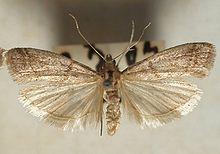| Cacao moth | |
|---|---|

| |
| Scientific classification | |
| Domain: | Eukaryota |
| Kingdom: | Animalia |
| Phylum: | Arthropoda |
| Class: | Insecta |
| Order: | Lepidoptera |
| Family: | Pyralidae |
| Genus: | Ephestia |
| Species: | E. elutella |
| Binomial name | |
| Ephestia elutella (Hübner, 1796) | |
| Synonyms | |
|
Numerous, see text | |
Ephestia elutella, the cacao moth, tobacco moth or warehouse moth, is a small moth of the family Pyralidae. It is probably native to Europe, but has been transported widely, even to Australia. A subspecies is E. e. pterogrisella.
The wingspan is 14–20 mm. Forewings in male are less elongate, with costal fold enclosing flocculent scales; grey, sprinkled with whitish and mixed with dark fuscous, towards dorsum often also with ferruginous-reddish; lines pale, dark-edged, first straight, rather oblique, second almost straight; two darker transversely placed discal dots. Hindwings pale fuscous, anteriorly thinly scaled, in 6 with median and subdorsal whitish-ochreous basal hair tufts. Larva brown-whitish; dots brown; head and plate of 2 reddish brown: on biscuit, chocolate, figs
This moth flies throughout the warmer months, e.g. from the end of April to October in Belgium and the Netherlands.
Infestation
Main article: List of tobacco diseases
The caterpillars of Ephestia elutella are often considered a pest, as they feed on dry plant produce, such as cocoa beans and tobacco, as well as cereals and dried fruit and nuts. Less usual foods include dried-out meat and animal carcasses, specimens in insect collections, and dry wood.
Tobacco and its related products can be infested by Lasioderma serricorne (tobacco beetle) and Ephestia elutella, which are the most widespread and damaging parasites to the tobacco industry. Infestation can range from the tobacco cultivated in the fields to the leaves used for manufacturing cigars, cigarillos, cigarettes, etc.
Taxonomy
This species has been known under a number of junior synonyms:
- Ephestia amarella Dyar, 1904
- Ephestia icosiella Ragonot, 1888
- Ephestia infumatella Ragonot, 1887
- Ephestia roxburghi (lapsus)
- Ephestia roxburghii Gregson, 1873
- Ephestia roxburgii (lapsus)
- Ephestia uniformata Dufrane, 1942 (variety)
- Homoeosoma affusella Ragonot, 1888
- Hyphantidium sericarium Scott, 1859
- Phycis angusta (Haworth, 1811)
- Phycis elutea Haworth, 1811; (unjustified emendation)
- Phycis rufa Haworth, 1811
- Phycis semirufa Haworth, 1811
- Tinea elutella Hübner, 1796
Footnotes
- Meyrick, E., 1895 A Handbook of British Lepidoptera MacMillan, London pdf
 This article incorporates text from this source, which is in the public domain. Keys and description
This article incorporates text from this source, which is in the public domain. Keys and description
- lepiforum.de includes images
 This article incorporates text from this source, which is in the public domain.
This article incorporates text from this source, which is in the public domain.
- Parsons, M. Clancey, C. 2023 A Guide to the Pyralid and Crambid Moths of Britain and Ireland Atropos Publishing ISBN 9780955108648
- Goater, B., Dyke . G. and Tweedie, R. 1986 British Pyralid Moths: A Guide to Their Identification ISBN 10: 0946589089 ISBN 13: 9780946589081
- Grabe (1942)
- ^ Ryan, L., ed. (1995). "Introduction". Post-harvest Tobacco Infestation Control. Norwell, Massachusetts and Dordrecht, Netherlands: Kluwer Academic Publishers. pp. 1–4. doi:10.1007/978-94-017-2723-5_1. ISBN 978-94-017-2723-5.
- See references in Savela (2009)
References
- Grabe, Albert (1942). "Eigenartige Geschmacksrichtungen bei Kleinschmetterlingsraupen" [Strange tastes among micromoth caterpillars] (PDF). Zeitschrift des Wiener Entomologen-Vereins (in German). 27: 105–109.
- Savela, Markku. "Ephestia Guenée, 1845". Lepidoptera and Some Other Life Forms. Retrieved July 18, 2017.
External links
| Taxon identifiers | |
|---|---|
| Ephestia elutella |
|
This Phycitini-related article is a stub. You can help Misplaced Pages by expanding it. |